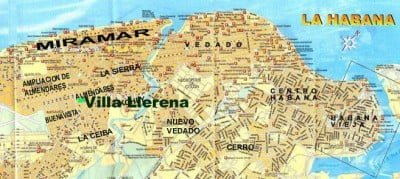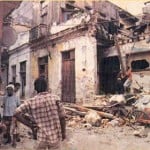Today is a grim day for me, and many Cubans. Every new year marks the same hideous anniversary.
Fifty-four years ago today, Cuba ceased to exist. Yeah, sure, that island is still known as Cuba. But, in truth, it has been the personal possession of the Castro dynasty ever since the first of January, 1959. Its proper name should be Castrolandia, or Castrolonia or Castrilla, or something like that.
Being Cuban is a lot like living in a very, very long Hitchcock film, or in a nightmare that never ends and has no end in sight.
Fifty-four years of enslavement and decay, with moronic sociopaths at the helm.
Worst of all, many throughout the world –and especially many in the thinking class — praise those moronic leaders and their totalitarian regime.
These outsiders know nothing, really. A few are despots at heart, or racists who think that inferior folk such as Cubans need despots to save them from starvation. Most of these opinionated outsiders are simply ignorant. And they tend to think that the two million of us who fled from Castrolandia are unreasonable, even insane. How can we fail to appreciate the great improvements made by Fidel Castro and his henchmen?
Forget the health care and the education so constantly over-hyped by Castronoids. We who lived there know how awful the health care is, and how the so-called education is little more than an attempt at mind control. We also know that all of the statistics related to these two great “achievements” are bogus.
Forget the suppression of human rights, forget the tens of thousands of Cubans tortured and murdered. If you can.
This new year, after 54 years of enslavement, it’s high time to review the physical achievements of the so-called Revolution, and consider why there is really nothing to celebrate on this morbid anniversary.
This new year marks a half-way point in Cuban history. At this point, today, Cuba has been dominated by the presence of the Castro dynasty for just as long as it was not.
Cuba became an independent republic in 1902. Fifty-four years later, in 1956, Fidel Castro began his so-called Revolution. After three years of minor victories way out in the boonies, Fidel received enough favorable press to scare the Eisenhower administration into pulling the rug out from under president Batista. Fidel and his bearded warriors came down from the mountains and jailed, killed, and exiled all who failed to agree with Fidel, including many who had fought against Batista. By 8 January, 1959, Fidel and his henchmen had taken control of Cuba. Now, in 2013, the Castro dynasty has been in power for 54 years.
Comparing the two 54-year periods on a single issue can be illuminating, and also very depressing. The issue is new construction. The question to ask is: what has the so-called Revolution built?
In case you didn’t notice while you were in school, historians tend to measure the greatness of cultures and civilizations through what they have built. Yes, through buildings, roads, bridges, aqueducts, temples, churches, and so on.
A comparison between the first 54 years and the succeeding 54 needs to take the following into account.
Pre-Castro
• In 1902, the population of Cuba was nearly 1.5 million (a 200,000 decrease from 1895, due largely to the genocidal policies of the Spanish government during Cuba’s final war of independence).
• Between 1900 and 1930, the first three decades of Cuban independence, about one million immigrants flooded into the island, mostly European, and mostly northern Spaniards. This population tsunami also included Asians, Levantines, and Jews. These immigrants doubled the population of the island and changed its complexion, literally. Tens of thousands of immigrants continued to flow into Cuba every year after that, up to 1958. Immigration from the U.S. was comparatively slight, but in 1958 there were more Americans living in Cuba than Cubans in the U.S.A. Emigration from Cuba was minimal during this half century.
• Rates of immigration as high as this and of emigration as low require a robust and growing economy, and a considerable degree of political stability.
• Cuba’s economic success can be measured very accurately by tracing the growth of Havana, both in terms of population and construction. Around 1902, Havana was still a very small city, which had just begun to expand beyond its colonial enclosure, known as “Old Havana.” This can be clearly seen in this map from that era, which shows the paved streets in the city: blue is Old Havana, red is the new expansion.
• In contrast, a map from 1956, the year Castro enters Cuban history, shows an astonishing rate of growth.
Post-Castro:
• Since 1959, Cuba has had no immigration.
• Since 1959, nearly two million Cubans have left the island (a figure larger than the entire population of Cuba at the time of independence).
• Since 1959, the population of the island has nearly doubled, despite a constant flow of emigration and despite the highest rate of abortion in the Western hemisphere, estimated to be equal to the number of live births.
• Since 1959, despite a growing population, Havana has seen virtually no new construction, and no expansion beyond its pre-Castro boundaries. The latest satellite photographs of Havana reveal few structures that were not already in place by 1958, and many empty spaces created by collapsed buildings.
• Since 1959, the existing infrastructure has deteriorated, and the city is now in ruins.
• During the era of Soviet dominance, very little new construction took place, and its quality was notoriously poor. Practically all new construction in Cuba since the collapse of the Soviet Union in 1991 has been intended for tourists, not for Cubans. These new facilities—often isolated from the general populace – continue to be inaccessible to Cubans.
• Cuba is now one of the poorest countries in the Western Hemisphere, and its people live largely cut off from the rest of the world, stuffed into inadequate housing.
Most of the buildings in Havana all tourists marvel at were built between 1902 and 1956, or, at the very latest, 1959. After that, the clock stopped. Havana is some sort of weird tropical Hiroshima, where some bomb was dropped and the hands on the clock were frozen at that exact moment. The bomb was the Castro dynasty. And tourists love to gawk at the ruins, and the ragged desperate Cubans who inhabit them. Some them even say that they hope Havana never changes from its present state, simply because they care more about their warped neocolonial sensibilities than they do about Cubans.
Yeah. Fifty-Four years of devolution. Vamos requetebien.








Another aniversary to remind us when we lost the land we where born…
Now a days our adopted country is facing a similar predicament (but in a different way).
I wonder if those in our Congress understand what’s at stake…
I don’t think I’m exaggerating when I say parts of Havana look like Berlin in 1945.
Amen, Freedom.
I read this and can’t help comparing this to Israel vs. the Palestinians. Israel since 1948 is like Cuba’s history in the first half of its existence. From rubble, desert, little water, land that had lain unusable, it is amazing what has emerged due to the ingenuity of those who developed their new country in Israel. Inventions used by the whole world, fruits and vegetables exported to the bread baskets of Europe and cotton to Georgia, more IPO’s per capita than anywhere else in the world, education, music, culture, Nobel prizes, medical advances, and freedom and representation in Parliament for every citizen, you name it. Yet the world reviles this magnificent country.
In the new Arab territories no achievement, old buildings, no inventions, nothing to show for their existence but bombs, mostly imported, and hatred, pride when their children kill themselves as long as they kill others whom they decide to perceive as enemies, nothing made to improve the world, yet the world makes excuses for them and blames Israel for the nothingness that is life in these territories.
This is an upside down world. If I try to tell people about Cuba as it is described here, I am met with yes, but what about Batista, or disbelief or boredom.
I despair. And these are only the first hours of the new year.
The ostensibly freedom-loving world is largely fine with this–for Cuba. Do the math. And don’t just get mad, but act on it.
And they’re not the “thinking class,” unless you mean wishful thinking, delusions or fantasies. It’s more accurate to call them the presuming class, as they presume far too much far too often. Of course they’re convinced they’re correct, because they’re full of themselves and their presumed superiority. There are few things more contemptible than perverted intelligence or talent used for evil. It’s a very old problem, as old as a certain angel named Lucifer who presumed too much, with disastrous results.
You are absolutely correct, Asombra. My use oI the term “thinking class” is purely sarcastic. In addition to their presumption, the self-appointed members of that class live out a hypocritical life, for they profess to be class-blind and race-blind egalitarians, but look down on all who didn’t go to the “right” schools or live in the “wrong” places, or fail to worship the New York Times, the New York Review of Books, The New Republic, and a few other publications. They are extremely class-conscious in this respect, and proud of it. One of their distinguishing traits is their incurable blindness to their deep-seated prejudices and to the narrow boundaries of their thinking.